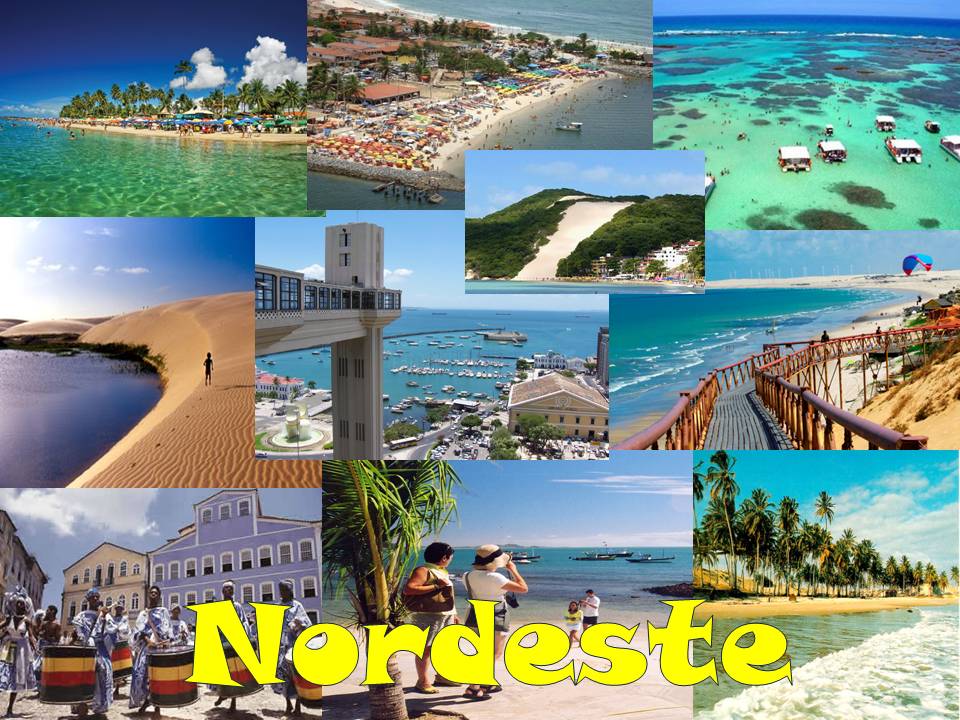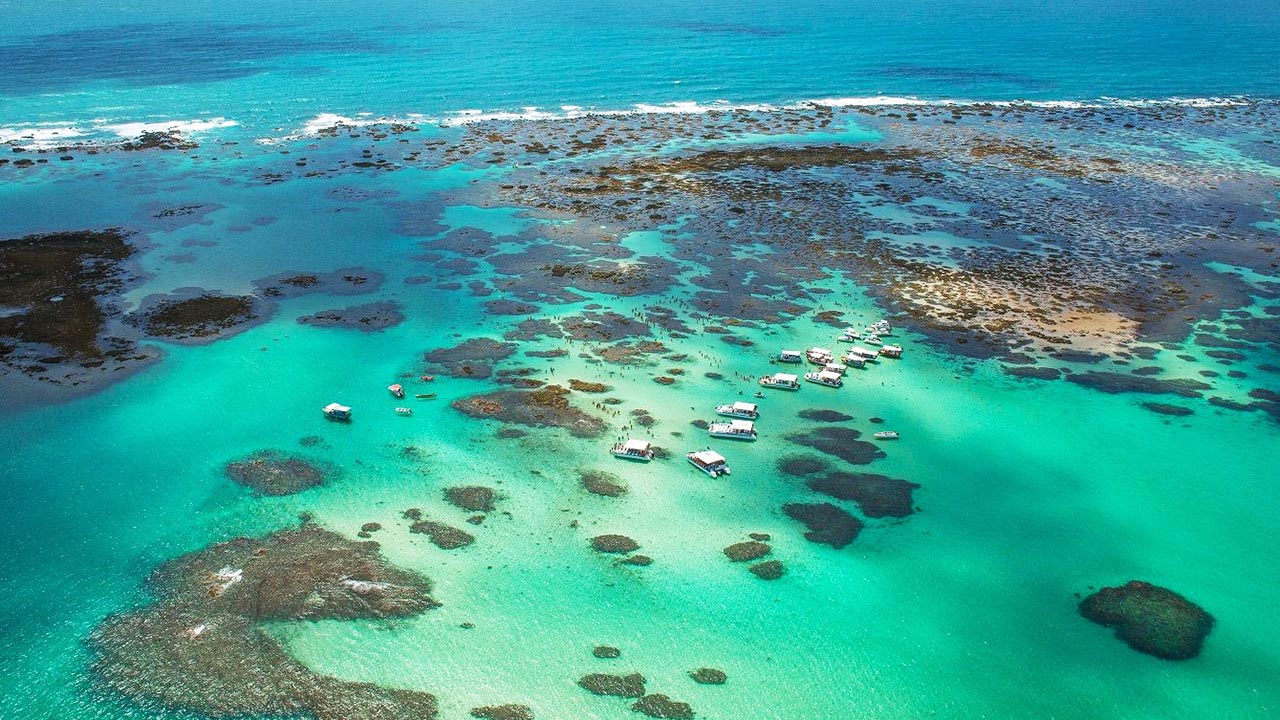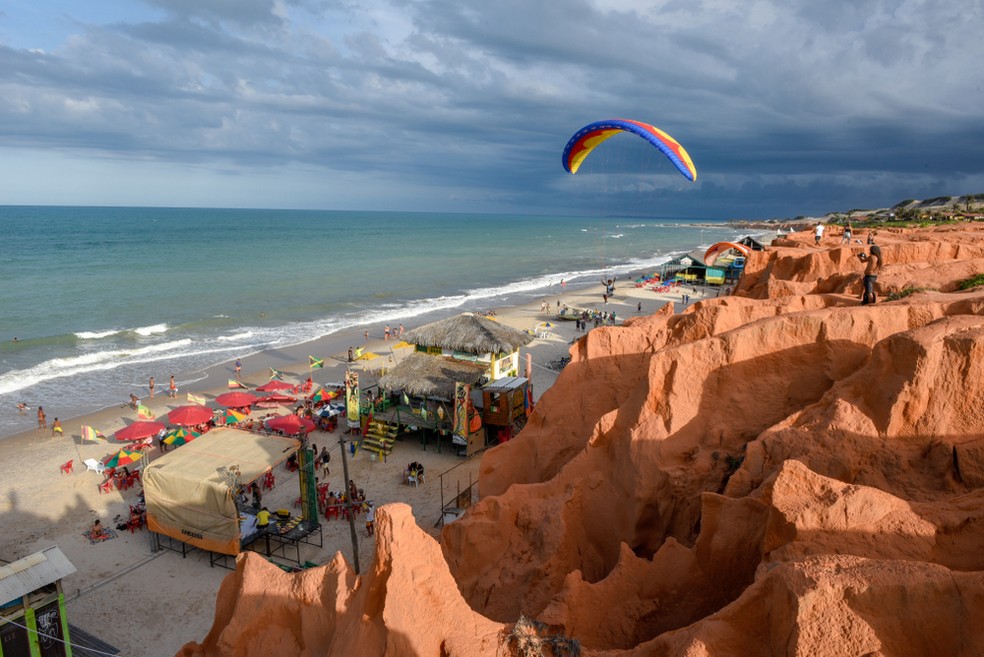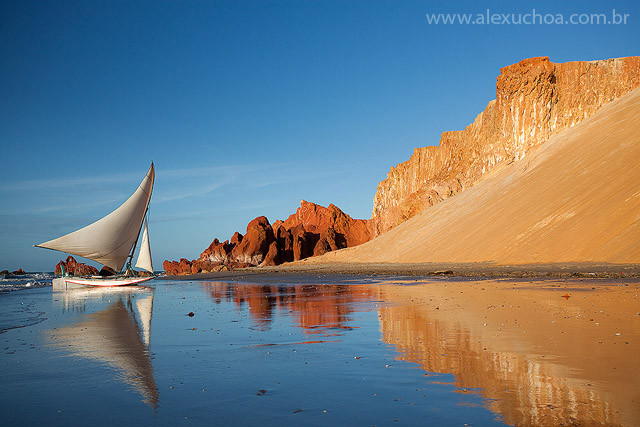Este post também está disponível em:
Português
English

The Brazilian northeast has a huge variety of tourist destinations, which is extremely well endowed with natural beauty, which is not simply limited to its beautiful beaches.
As a result, this is one of the Brazilian regions with the greatest tourism potential, an activity that helps to move and boost the local economy.
In all, there are dozens or even hundreds of points with tourist potential involving natural resources, of which we will highlight the main ones.
One of the geographical advantages of the Northeast region is the fact that practically all of its states have three types of natural landscapes: the coastal ones (of which the beautiful beaches stand out), those of closed forest and those related to the semi-arid.
Northeast Brazil offers:
Beaches
The northeastern beaches are undoubtedly among the most beautiful in Brazil and the world. With beautiful landscapes favoured by the wide coastal extension of the region, they also stand out for their diversity, with those that are better known and busier and those that are less hectic, catering to all preferences.
Among the main beaches, the following stand out: Porto Seguro (BA), Praia do Gunga (AL), Praia do Espelho (BA), Jericoacoara (CE), Canoa Quebrada (CE), Porto de Galinhas (PE), Genipabu (RN), Praia da Pipa (RN), and many others.
Tourist Tours
Among the sightseeing tours, the biggest attractions are around the relief formations in dunes, in addition to some coastal points of high beauty. Among them, we can mention the Lençóis Maranhenses (MA), Lajedo de Soledade (RN), Praia Fluvial do Jacaré (PB), the Passeio das Galés in Maragogi (AL), Itaparica Island (BA), among countless other spots.
Matas, Rivers and Waterfalls
The Northeast has three main types of forest domains: Atlantic Forest, Caatinga and, in some places, Cerrado. For this reason, this region has numerous natural beauties related to these phytogeographic formations, of which we highlight: Lençóis (municipality of Bahia with a large number of beautiful waterfalls), Cachoeira da Pedra Caída (MA), Delta do Rio Paranaíba (PI), Parque Nacional Serra da Capivara (PI), Chapada Diamantina (BA) and countless other natural wonders.
Just by mentioning a few locations, we can already notice that the Northeast is extremely rich in natural beauty, presenting a range of possibilities for tourists with the most diverse preferences possible.
Main Tourist Destinations in the Northeast

Principais Destinos Turísticos no Nordeste
Maragogi in Alagoas
Maragogi is one of the most popular destinations in the state of Alagoas because of the galés, the coral banks that form gigantic natural pools at low tide.

But unlike Rota, Maragogi is already a very crowded and mass tourism destination, so be prepared to see crowded boats and loud music in the galleys.
Maragogi is known as the ‘Brazilian Caribbean’ moulded by the tide table and the phases of the moon.
Maragogi has transparent, warm waters full of fish. The natural pools – or galés – of Maragogi, on the northern coast of Alagoas, make the region known, at least by the proud natives, as the “Brazilian Caribbean”.
The region is a favourite with the locals, who have a lot of fun in the area.
You can reach the pools in about 20 minutes by speedboat or catamaran. There, a dozen species of colourful fish swim and interact with tourists in a sea typical of Central American regions.
<p
There are days when getting to the galleys is impossible and, on certain dates, the galleys “run” for four hours – two before and two after the lowest tide level of the day. The phases of the moon influence this “dance” of the sea.
Maragogi is a 2-hour drive from Recife.
Morro de São Paulo and Boipeba in Tinharé, BA
Coconut palms, blue water, natural pools and a charming village make Morro de São Paulo one of the Brazilian destinations that resemble the Caribbean. There, the beaches are named after numbers: 1, 2, 3 and 4.
The higher the number, the further away from the centre and the tents, and the more beautiful the nature.

If you want somewhere quiet, and good for swimming, head to the third and fourth beaches. They are perfect for snorkelling and, at low tide, are clear water pools.
If you want the hustle and bustle, restaurants, beach huts and night parties, stick to the first and second.
It’s also worth taking a trip to Boipeba and Moreré.
In these two places, the maxim is to relax. It’s the Bahia of 30 years ago, with a fisherman’s atmosphere, natural pools and beaches lined with coconut palms. Take a break at Praia da Cueira and go to Ponta dos Castelhanos.
Salvador is the closest airport to Valença (about 2h/3h), which is where the ferry to Morro leaves from.
In Valença, you will have to leave your vehicle in a car park. There are several near the ferry.
From Valença to Morro: boats and speedboats make the journey to Morro de São Paulo daily, from 7am to 6pm, every hour.
The boat takes 1h40min and the speedboat 40m. The prices were R$7.00 and R$14.00 respectively per person per way.
From Morro to Boipeba, the way is by 4X4 car.
Canoa Quebrada in Aracati, CE
The beach of Canoa Quebrada, the famous beach of Aracati considered one of the main tourist destinations of the East Coast.

The cliffside setting began attracting visitors as early as the 1970s and has become an international benchmark for sun and beach tourism, according to the National Tourism Development Programme.

Today, the hotel network in the city holds thousands of Brazilians and foreigners who come to know the attractions of dunes, buggy rides and the famous Broadway, an avenue where bars, restaurants and nightclubs teem.
Ponta Grossa Beach in Icapuí
Ponta Grossa Beach is less known on the tourist route, so it still retains the tranquility of the old fishing villages, but also offers fun and adventure to visitors with raft, buggy or quad rides.
A beautiful place with the most beautiful formations in the region, it is about 50 kilometres from Canoa Quebrada.

Located almost on the border with Rio Grande do Norte, Ponta Grossa is the biggest tourist attraction of Canoa Quebrada.
It is also the final stop for buggy rides that usually leave from the leisure centre of Canoa.
It is also the final stop of the buggy rides that usually leave from the leisure centre of Canoa.
Ponta Grossa beach gathers together the most popular tourist attractions of Canoa Quebrada.
Ponta Grossa beach has red cliffs, beautiful dunes, reefs and old fishing villages along the way.
The beach is also the final stop for buggy rides from the leisure centre of Canoa.
The Ponta Grossa dune is one of the most visited tourist spots in the region, it belongs to the (APA) environmental preservation area and is located in the municipality of Icapuí, but can be seen from the beach of Canoa Quebrada 50 kilometres away (more or less).

Praia de Ponta Grossa em Icapuí CE
A very magical place of surprising beauty. The rocks are in shades of reddish-orange to the reflections of the sands of the high dunes and natural pools that form along the hard rocks and sand.
<p
In the village of Ponta Grossa it is also possible to rent rooms and spend a few days at rest and even in a quick tour with buggy it is possible to appreciate delicious fresh lobsters, giant prawns at prices well below the market alongside the friendliness of fishermen and locals.
The ride to Ponta Grossa lasts about two and a half hours and can be done either in the morning or in the afternoon, depending on the tide level.
The ride to Ponta Grossa lasts about two and a half hours and can be done either in the morning or in the afternoon, depending on the tide level.
The route to Ponta Grossa includes several beaches: Majorlandia, Lagoa do Mato, Quixaba, Retirinho, Fontainha, Retiro Grande. All of them have different characteristics and beauties that are worth knowing.
Ponta Grossa beach is a great place to visit.
Tambaba Beach in Paraíba
Known for being the first beach officially recognised as a naturalist in the Northeast, Tambaba also ranks as one of the most beautiful beaches in Paraíba. Located in Conde, on the south coast of the state, the beach is a destination for many tourists who love tranquillity and a charming look.

It is the cliffs, the warm water and the emerald-coloured sea that make the place attractive to visitors, in addition to the walks, vegetation, cuisine and surfing practiced there. The beach, which is 35 kilometres from João Pessoa, is part of an environmental protection area (APA) and is considered one of the cleanest in Paraíba.
The beach also has a coconut tree that was born on a rock located inside the sea, and has become one of the attractions of the place, especially for those who like to photograph.
Because it is a naturist beach, Tambaba is divided into two sides. What separates the two areas is a staircase that takes naturists to a reception, where they are introduced to the rules of the place, among them, the non-authorisation to take pictures.
Praia dos Carneiros in Pernambuco.

Praia dos Carneiros is located in the municipality of Tamandaré, on the south coast of Pernambuco, and is considered by Pernambucans as the most beautiful beach in the state and has already been classified by the famous website TripAdvisor as the second most beautiful beach in Brazil.
The destination is very popular with tourists from all over Brazil and foreigners of different nationalities. Carneiros is an ideal destination for people of all ages, tastes and budgets.
The little chapel of São Benedito, which is the main symbol of the region, was built in the 18th century and has turned the beach into a popular destination for honeymooners and even those who get married in the various inns that exist along the waterfront.
On the weekend we were there a beautiful wedding took place.
There are about 5 km of coastline full of coconut trees, paradisiacal beaches with warm and transparent waters that meet the Rio Formoso and an extensive barrier reef full of marine life.
In the dry Mare are formed several sandbanks and several natural pools that are a separate attraction for tourists visiting the region.
It is about 186 km from Maceió, capital of Alagoas, and 99 km from Recife, capital of Pernambuco.
Serra da Capivara National Park in Piauí
In the Serra da Capivara, visiting the Serra da Capivara National Park, a Unesco World Heritage Site, is a true journey to the origins of civilisation in America.

With a unique landscape of canyons, lowlands and mountains, and a huge concentration of prehistoric rock art (with paintings between 6,000 and 12,000 years old), it is one of the best-structured parks in the country.
Trained guides, who are obligatory on the visit, help to understand the meanings of the drawings. The base for visiting the National Park is the modest São Raimundo Nonato, 41 km away, with good infrastructure.
Genipabu Beach in RN
The name is derived from the indigenous term “jenipapo”, and as instructed by the Brazilian Academy of Letters, indigenous terms should be emphasised with “j”, however, the registration of the municipality was made with “g”, and so has been used by residents, press and official bodies of the region.
Located just 25 km from the centre of Natal, on the North Coast of the State, the Praia de Genipabu is one of the main postcards of Rio Grande do Norte. Its white dunes are considered the highest in the country, and the freshwater lagoons complete the landscape that looks more like an oasis in the middle of the desert. Exotic dromedaries make one of Brazil’s best-known summer holiday settings even more magical.
The beautiful Genipabu is also a much sought after destination among tourists on buggy tours. This route is known not only for its beauty, but also for the famous phrase “With or without emotion?”, referring to the speed and intensity of the manoeuvres during buggy rides.
The Dunas de Genipabu Ecological Tourist Park encompasses not only a beach, but a set of dunes, a lagoon and an Environmental Preservation Area located in the municipality of Extremoz.
Xingó Canyon in Sergipe
The city of Canindé de São Francisco, located 213 km from Aracaju, in the Alto Sertão sergipano, is the gateway for those who wish to visit the Xingó Tourist Complex, which comprises the states of Sergipe, Alagoas and Bahia.

Every day, about 1.5 thousand tourists from different parts of the country take the tour to the Xingó Canyon, the region’s business card and which has projected the municipality on the tourist map of the state and Brazil.
By the waters of the “Velho Chico”
The natural scenery formed by the vegetation of the caatinga and all the exuberance of the São Francisco River can be followed from the beginning of the tour at Porto Karrancas, located on the dam dike of the Xingó Hydroelectric Power Plant, built in the 1970s, and which gave rise to the 5th largest navigable canyon in the world.
The Xingó Canyon is formed by a deep valley, 65 kilometres long, 170 metres deep and ranging in width from 50 to 300 metres. It is from this point that catamarans leave daily from 8.30 am to 2 pm;
It takes 3 hours of navigation and during the journey rocky formations of reddish and grey granite are imposing along the 18 km of river. The main ones are: Pedra do Gavião, Morro dos Macacos, Pedra do Japonês and Paraíso do Talhado. The greenish immensity of the waters of the “Velho Chico” contrasts with the rustic landscape and enchants visitors.
After an hour and a half of travelling, the boat arrives at the “Gruta do Talhado”, which appears through the immense stone walls. This is the moment when tourists can then enjoy bathing in the waters of the São Francisco River, full of history and tradition, as well as contemplating more closely the walls of more than 30 metres high. The dive at this point is also impressive, as it is approximately 25 metres deep.
Praia do Espelho in Caraíva BA
In Praia do Espelho, located in the district of Caraíva you will find everything a beach needs to be elected one of the most beautiful. It is a spectacle of nature that deserves your visit!

This beautiful beach has clear and calm water, a large stretch of sand, natural pools, restaurants and a small bar on the beach, not to mention the cliffs that surround it contribute to make the landscape unique.
It is one of the most desirable destinations in the south of Bahia – and one of the most expensive. The inns, with their sun loungers and gazebos protected by the shade of the trees, gain a charming atmosphere at night, lit by candles.
And the tranquil sea, which shows its greenish hues in the sunlight, takes on silvery reflections during the full moon. If the goal is to save money, the best way to visit Praia do Espelho is to make a round trip from Arraial d’Ajuda or Trancoso.
Praia do Espelho is a nickname for Praia do Caruípe, which is located in the village of the same name, in the district of Caraíva, a riverside community in Porto Seguro, BA.
The nickname arose due to the effect caused by the sun’s reflections on the natural pools when seen from the sea.
Brazilian Northeast Tourism Guide



















